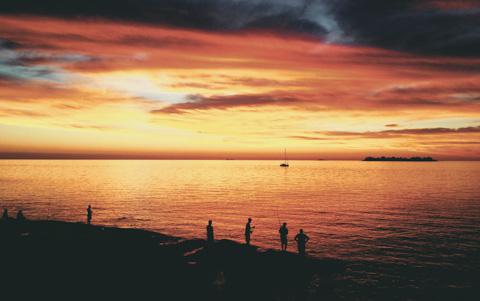How much does it cost to travel to Uruguay?
You should plan to spend around $80 ($U3,102) per day on your vacation in Uruguay. This is the average daily price based on the expenses of other visitors.
Past travelers have spent, on average for one day:
- $24 ($U918) on meals
- $23 ($U879) on local transportation
- $72 ($U2,770) on hotels
A one week trip to Uruguay for two people costs, on average, $1,125 ($U43,421). This includes accommodation, food, local transportation, and sightseeing.
All of these average travel prices have been collected from other travelers to help you plan your own travel budget.
Independent Travel
Traveling Independently has many benefits including affordabilty, freedom, flexibility, and the opportunity to control your own experiences.
All of the travel costs below are based on the experiences of other independent travelers.
Is Uruguay expensive to visit?
Uruguay is a reasonably affordable destination to visit. It is in the top 25% of countries in the world for its affordability. If you're traveling on a budget, then this is a good destination with affordable accommodation, food, and transportation.
Within South America, Uruguay is somewhat more expensive compared to the other countries. It is in the top 25% of countries in South America for its travel costs. While a few countries in the region are more expensive, Uruguay is more expensive than most.
For more details, see Is Uruguay Expensive?
How much money do I need for a trip to Uruguay?
The average Uruguay trip cost is broken down by category here for independent travelers. All of these Uruguay travel prices are calculated from the budgets of real travelers.
|
Category
|
Cost
|
|
Accommodation 1
(Double Occupancy)
|
$U2,770
($72)
|
|
Local Transportation 1
|
$U879
($23)
|
|
Food 2
|
$U918
($24)
|
|
Entertainment 1
|
$U604
($16)
|
|
Alcohol 2
|
$U177 -
530
($5 - 14)
|
Accommodation Budget in Uruguay
Calculated from travelers like you
The average price paid for one person for accommodation in Uruguay is $36 ($U1,385). For two people sharing a typical double-occupancy hotel room, the average price paid for a hotel room in Uruguay is $72 ($U2,770). This cost is from the reported spending of actual travelers.
Looking for a hotel in Uruguay? Prices vary by location, date, season, and the level of luxury. See below for options.
Local Transportation Budget in Uruguay
Calculated from travelers like you
-
The cost of a taxi ride in Uruguay is significantly more than public transportation. On average, past travelers have spent $23 ($U879) per person, per day, on local transportation in Uruguay.
-
Local Transportation1
Taxis, local buses, subway, etc.
$23
$U879
Food Budget in Uruguay
Calculated from travelers like you
-
While meal prices in Uruguay can vary, the average cost of food in Uruguay is $24 ($U918) per day. Based on the spending habits of previous travelers, when dining out an average meal in Uruguay should cost around $9.52 ($U367) per person. Breakfast prices are usually a little cheaper than lunch or dinner. The price of food in sit-down restaurants in Uruguay is often higher than fast food prices or street food prices.
-
Food2
Meals for one day
$24
$U918
Entertainment Budget in Uruguay
Calculated from travelers like you
-
Entertainment and activities in Uruguay typically cost an average of $16 ($U604) per person, per day based on the spending of previous travelers. This includes fees paid for admission tickets to museums and attractions, day tours, and other sightseeing expenses.
-
Entertainment1
Entrance tickets, shows, etc.
$16
$U604
Alcohol Budget in Uruguay
Calculated from travelers like you
-
The average person spends about $9.16 ($U354) on alcoholic beverages in Uruguay per day. The more you spend on alcohol, the more fun you might be having despite your higher budget.
-
Alcohol2
Drinks for one day
$9.16
$U354
Water Budget in Uruguay
Calculated from travelers like you
-
On average, people spend $1.32 ($U51) on bottled water in Uruguay per day. The public water in Uruguay is considered safe to drink.
-
Water2
Bottled water for one day
$1.32
$U51
Last Updated: Sep 6, 2023
Uruguay On a Budget
 Colonia del Sacramento, Uruguay
Colonia del Sacramento, Uruguay
In the wilds of South America is a small country full of an energy and vibrancy that any traveler will find enticing. Uruguay, meaning river of the colorful birds, is a country full of rich agricultural history among the locals, and a country to be desired by immigrants.
At a Glance
Uruguay is often referred to as the Switzerland of the South America due to its stable democracy and social benefits. It has low crime rates by South American standards, and is generally thought to be a great place to live.
The country is split into several regions. The Atlantic Coast is full of great beach resorts and the land crossing to Brazil, while the Rio de la Plata is home to the capital city of Montevideo and the gateway to Argentina. The Northern Interior is where you'll find the gaucho culture and citrus fields, and in the Central Interior is the hub for agriculture and the dams on the Rio Negro.
There are several options when it comes to transportation around the country of Uruguay. There is an extensive bus system that all operate out of Tres Cruces station. The buses are frequent, safe and very comfortable. Taxis are safe and fairly affordable as they all have meters and are fixed costs. If you get into a taxi without a meter, you may want to get out and find another taxi. To rent a car, most residents (including the US) only need their driver's license, passport and a credit card. Beware that gas is heavily taxed in Uruguay, and because of that the country is filled with fuel-efficient manual transmissions. Driving in Uruguay is similar to Europe, but with more roundabouts. Because of the prevalence of manual cars, many locals will jump the green light, so always stop at the yellow lights at an intersection.
The language of Uruguay is Spanish, and most do not use the English they learned in school. Outside Montevideo and Punta del Este, you'll be hard pressed to find an English speaker.
Related:
Looking for a
party hostel in Rio,
Sao Paulo,
Lima, or
Buenos Aires?
Traveling alone through
Argentina?
Top Tourist Attractions
Uruguay's capital city, Montevideo, has plenty of sights to see and ways to fill the day. Wander Parliament Place and Independence Plaza, or take an adventure to the neighborhoods of Carrasco, Punta Gorda and Pocitos and stroll along the beaches and promenades. The city is littered with sections of old and new from the Puerta de la Ciudadela - the remnants of an old wall that once surrounded the city - all the way to the modern shops of Las Ramblas.
Another popular spot in Uruguay is the quiet, backpacker paradise of Punta del Diablo. While recent expansion has grown the area, most of it has stayed inland, leaving the coast to its peace and quiet it's known for. To avoid the crowds of tourists, visit Punta del Diablo during any time of the year outside of the winter. The first half of January, for example, has as many as 30,000 visitors up and down the beaches.
For the traveler who loves the animal kingdom, just north of La Paloma is Cabo Polonio. Here you can visit Uruguay's second largest sea lion colony. You'll find it near a fishing village surrounded by sand dunes. Declared a national park in 2009, this area is protected under Uruguay's SNAP program. Even though there have been a growing number of tourists to the area, Cabo Polonio is still one of the country's most rustic fishing villages. Keep in mind, this town has no banking and limited electricity.
Spanning across the Arroyo de las Vacas stream is the city of Carmelo. Founded in 1816 is a quiet town full of cobblestone streets and old homes. Add this city to your itinerary to enjoy the yachting, fishing and the Parana Delta. Just south of the arroyo is the pleasant getaway of Playa Sere. This beach is a great spot with a large park, open space, camping, swimming and casino.
Popular Foods
Uruguayan cuisine is primarily Spanish with a influences of Italian thanks to the country's long history of Italian immigration. The meat lovers will find plenty of options at the public markets, but there are also plenty of options for vegetarians.
Specialty dishes you'll want to look for include empanadas, gramajo, locally sourced steaks, chivito, asado, and sneak a little dulce de leche for dessert.
We've been gathering travel costs from tens of thousands of actual travelers since 2010, and we use the data to calculate average daily travel costs for destinations around the world. We also systematically analyze the prices of hotels, hostels, and tours from travel providers such as Kayak, HostelWorld, TourRadar, Viator, and others. This combination of expenses from actual travelers, combined with pricing data from major travel companies, gives us a uniqe insight into the overall cost of travel for thousands of cities in countries around the world. You can see more here: How it Works.
 Colonia del Sacramento, Uruguay
Colonia del Sacramento, Uruguay

 Budget Your Trip is all about finding out how much everything costs so that you can travel cheaper and longer. Created by avid travelers Laurie and Bryan, our goal is to help you plan your next trip on the right budget. With average daily travel costs that are calculated from the budgets of real travelers, plus an analysis of hotel and tour prices, you can find out how much money you need to plan your next adventure. We also have plenty of travel advice, accommodation reviews, and activity suggestions.
Budget Your Trip is all about finding out how much everything costs so that you can travel cheaper and longer. Created by avid travelers Laurie and Bryan, our goal is to help you plan your next trip on the right budget. With average daily travel costs that are calculated from the budgets of real travelers, plus an analysis of hotel and tour prices, you can find out how much money you need to plan your next adventure. We also have plenty of travel advice, accommodation reviews, and activity suggestions.